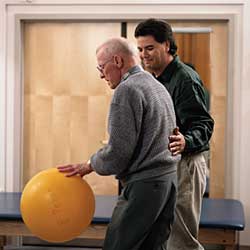Functionalizing Fitness
 It is 2004, we have rovers roaming the landscape of Mars, space colonies being planned for the moon and humans may soon be cloned. With all these new developments leaping mankind forward, there must be something grand going on in the world of health and fitness. Actually, when it comes to fitness training, we haven't leapt forward, we've leapt back?we have gone retro, and in a positive way.
It is 2004, we have rovers roaming the landscape of Mars, space colonies being planned for the moon and humans may soon be cloned. With all these new developments leaping mankind forward, there must be something grand going on in the world of health and fitness. Actually, when it comes to fitness training, we haven't leapt forward, we've leapt back?we have gone retro, and in a positive way.
Today, the importance of functional fitness is growing. Integrating balance and stability into our workouts helps prepare us for the dynamic environments of daily living. Carrying groceries, playing with our kids or participating in sports requires a great amount of coordination. By using equipment such as wobble boards, exercise balls, etc., you will improve your functional abilities. If you want to drastically improve sports performance, function better during your daily activities or reduce your chances of injury, then functional training is the way to go.
Functional training, however, is not a new concept. In fact, in the early 1900's functional training was all the rage. Calisthenics, involving gymnastic-type movements, was a common form of exercise. The first wobble board was actually developed in 1917. Training mimicked the labor-intensive lifestyles of the time. When your job depended on your physical condition, your training had to be very functional and very specific to the demands of the job.
As the decades passed, the pendulum shifted from a highly functional form of training, involving integration of balance and movement, to a more stable form of training that isolated movements. High-tech strength training and cardiovascular equipment were introduced and became the norm. These types of equipment no longer integrated movement patterns, but isolated them. When using such equipment, the ability to train balance and stability drastically declined.
Everything we do in our daily lives involves balance. |
By the mid 1980s, innovative health and fitness professionals began to swing the pendulum back in the direction of the 1900's way of thinking. Professionals understood that life is a balancing act. Everything we do in our daily lives involves balance. With this in mind, they began integrating balance and stability back into our exercise regime. Only now is functional training reaching its full impact.
Simply adding a few new products to your exercise workout can make you a functional fitness machine. As a guideline to developing your functional fitness, use equipment that can be used in a variety of planes and that works your stability, balance or agility. Here are a few exercise examples utilizing FitterFirst products:
Perform squats on a Wobble Board
Perform push ups on a Wobble Board
Try a one arm cable row, while kneeling on a Fitter Ball
Do your sit-ups on a Fitter Ball
Stand on a Rocker Board while passing a Medicine Ball
Practice your golf swing while standing on two Sit Fitters
Performing exercises such as these to improve your functional fitness will help you:
Improve your balance and stability
Have greater confidence in sports and daily living
Develop a better relationship with gravity
Decrease the chance of injury
Perform physical tasks with greater ease
Decrease the rate of wear and tear on your body as you age
Add a fun and challenging element to your workout
Functional fitness can have a huge impact on your life. Many of the things you enjoy come from the activities you perform each day; whether that is building a new fence for your home, throwing a frisbee in the park or simply playing with your kids. Our ultimate goal in life is to be happy. Maintaining your functional fitness will allow you to continue to do the activities that make you happy.
This article originally appeared in the May 2004 issue of HME Business.